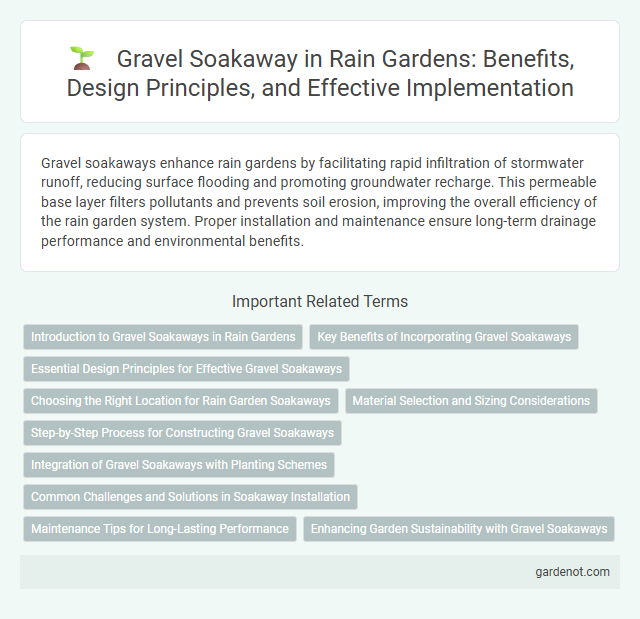Gravel soakaways enhance rain gardens by facilitating rapid infiltration of stormwater runoff, reducing surface flooding and promoting groundwater recharge. This permeable base layer filters pollutants and prevents soil erosion, improving the overall efficiency of the rain garden system. Proper installation and maintenance ensure long-term drainage performance and environmental benefits.
Introduction to Gravel Soakaways in Rain Gardens
Gravel soakaways are engineered drainage systems designed to enhance water infiltration in rain gardens by allowing stormwater to percolate through gravel layers. These soakaways reduce surface runoff, mitigate flooding risks, and promote groundwater recharge by temporarily storing and filtering rainwater. Incorporating gravel soakaways improves the efficiency of rain gardens in managing urban stormwater and supporting sustainable landscape practices.
Key Benefits of Incorporating Gravel Soakaways
Gravel soakaways significantly enhance rain garden performance by improving stormwater infiltration, reducing surface runoff, and minimizing flood risks. Their porous structure facilitates efficient groundwater recharge while filtering pollutants through natural soil processes. Incorporating gravel soakaways promotes sustainable urban drainage systems, supporting ecosystem health and reducing infrastructure strain.
Essential Design Principles for Effective Gravel Soakaways
Gravel soakaways require proper sizing based on soil permeability and expected rainfall volume to ensure efficient water infiltration. The design must incorporate clean, uniformly graded gravel to maximize void space and prevent clogging while incorporating a geotextile filter to stop sediment ingress. Positioning the soakaway at least 5 meters away from building foundations and ensuring a minimum 1-meter depth below the lowest drain outlet enhances structural protection and effective groundwater recharge.
Choosing the Right Location for Rain Garden Soakaways
Selecting the ideal location for a gravel soakaway in a rain garden requires assessing soil permeability and slope to ensure efficient water infiltration and prevent surface pooling. Positions near downspouts or impervious surfaces maximize runoff capture while avoiding areas with high water tables or underground utilities minimizes flooding and structural damage risks. Proper siting enhances the soakaway's performance in stormwater management and supports sustainable urban drainage systems.
Material Selection and Sizing Considerations
Gravel soakaways in rain gardens require careful material selection, prioritizing clean, angular gravel with a diameter of 10-40 mm to ensure optimal permeability and prevent clogging. Proper sizing is essential, typically calculated based on the catchment area and local rainfall intensity, with a volume capacity of at least 0.5 to 1 times the anticipated runoff to enable effective infiltration. Using locally sourced gravel with consistent particle size distribution enhances durability and drainage performance in sustainable stormwater management systems.
Step-by-Step Process for Constructing Gravel Soakaways
Constructing a gravel soakaway begins with selecting a suitable location away from building foundations to prevent water damage. Excavate a pit approximately 1 meter deep and fill it with clean, washed gravel ensuring effective infiltration; incorporate a perforated pipe wrapped in a geotextile membrane to enhance water dispersion and prevent soil clogging. Compact the surrounding soil and cover the gravel layer with topsoil, allowing the soakaway to efficiently manage stormwater runoff and reduce surface flooding.
Integration of Gravel Soakaways with Planting Schemes
Gravel soakaways enhance rain garden functionality by facilitating efficient infiltration and reducing surface runoff. Integrating gravel soakaways with diverse planting schemes supports root aeration and water uptake, promoting healthier vegetation and improved pollutant filtration. Strategic placement of gravel layers beneath permeable soils complements native and moisture-tolerant plants, optimizing water management and ecological benefits.
Common Challenges and Solutions in Soakaway Installation
Gravel soakaway installation often faces challenges such as poor soil permeability, leading to slow drainage and waterlogging. Using geotextile membranes can prevent soil infiltration and maintain gravel effectiveness, while selecting appropriate gravel size ensures optimal water flow. Regular maintenance including sediment removal and inspection helps prevent clogging and prolong soakaway functionality.
Maintenance Tips for Long-Lasting Performance
Gravel soakaways require regular inspection to prevent clogging and ensure effective water infiltration. Clearing debris and sediment buildup every six months maintains permeability and reduces the risk of waterlogging. Periodic replenishment of gravel layers helps preserve structural integrity and supports long-lasting performance in rain garden systems.
Enhancing Garden Sustainability with Gravel Soakaways
Gravel soakaways improve garden sustainability by efficiently managing stormwater runoff and promoting groundwater recharge. By allowing rainwater to percolate through permeable layers, they reduce soil erosion and prevent waterlogging in rain gardens. Integrating gravel soakaways supports eco-friendly landscaping practices, minimizes flooding risk, and enhances plant health by maintaining optimal soil moisture levels.
Gravel soakaway Infographic

 gardenot.com
gardenot.com